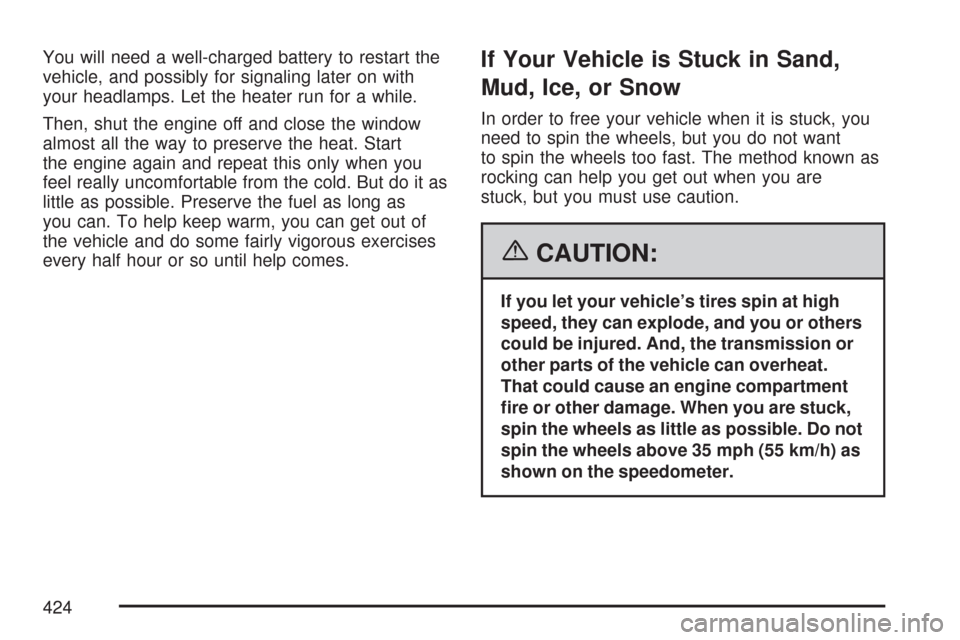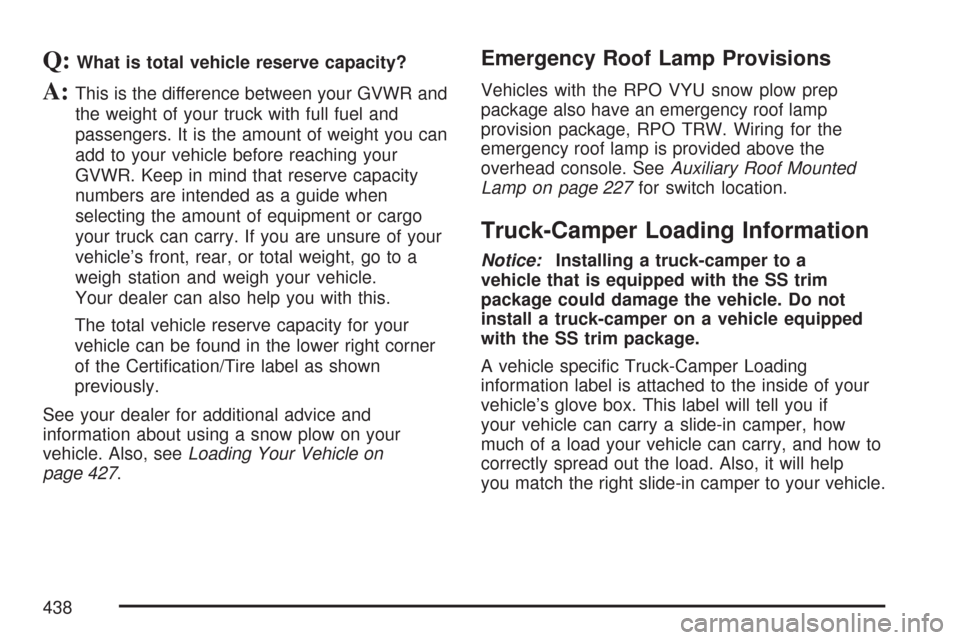Page 424 of 684

You will need a well-charged battery to restart the
vehicle, and possibly for signaling later on with
your headlamps. Let the heater run for a while.
Then, shut the engine off and close the window
almost all the way to preserve the heat. Start
the engine again and repeat this only when you
feel really uncomfortable from the cold. But do it as
little as possible. Preserve the fuel as long as
you can. To help keep warm, you can get out of
the vehicle and do some fairly vigorous exercises
every half hour or so until help comes.If Your Vehicle is Stuck in Sand,
Mud, Ice, or Snow
In order to free your vehicle when it is stuck, you
need to spin the wheels, but you do not want
to spin the wheels too fast. The method known as
rocking can help you get out when you are
stuck, but you must use caution.
{CAUTION:
If you let your vehicle’s tires spin at high
speed, they can explode, and you or others
could be injured. And, the transmission or
other parts of the vehicle can overheat.
That could cause an engine compartment
�re or other damage. When you are stuck,
spin the wheels as little as possible. Do not
spin the wheels above 35 mph (55 km/h) as
shown on the speedometer.
424
Page 436 of 684
Q:What is front axle reserve capacity, and
how do I calculate it?
A:Front axle reserve capacity is the difference
between your front Gross Axle Weight Rating
(GAWR) and the front axle weight of your
vehicle with full fuel and passengers. Basically,
it is the amount of weight you can add to your
front axle before reaching your front GAWR.
The front axle reserve capacity for your vehicle
can be found in the lower right corner of the
Certi�cation/Tire label, as shown.In order to calculate the amount of weight any
front accessory, such as a snow plow, is adding to
the front axle, use the following formula:
(W x (A + W.B.)) /W.B.= Weight the accessory is
adding to the front axle.
Where:
W = Weight of added accessory
A = Distance that the accessory is in front of the
front axle
W.B. = Vehicle Wheelbase
United StatesCanada
436
Page 438 of 684

Q:What is total vehicle reserve capacity?
A:This is the difference between your GVWR and
the weight of your truck with full fuel and
passengers. It is the amount of weight you can
add to your vehicle before reaching your
GVWR. Keep in mind that reserve capacity
numbers are intended as a guide when
selecting the amount of equipment or cargo
your truck can carry. If you are unsure of your
vehicle’s front, rear, or total weight, go to a
weigh station and weigh your vehicle.
Your dealer can also help you with this.
The total vehicle reserve capacity for your
vehicle can be found in the lower right corner
of the Certi�cation/Tire label as shown
previously.
See your dealer for additional advice and
information about using a snow plow on your
vehicle. Also, seeLoading Your Vehicle on
page 427.
Emergency Roof Lamp Provisions
Vehicles with the RPO VYU snow plow prep
package also have an emergency roof lamp
provision package, RPO TRW. Wiring for the
emergency roof lamp is provided above the
overhead console. SeeAuxiliary Roof Mounted
Lamp on page 227for switch location.
Truck-Camper Loading Information
Notice:Installing a truck-camper to a
vehicle that is equipped with the SS trim
package could damage the vehicle. Do not
install a truck-camper on a vehicle equipped
with the SS trim package.
A vehicle speci�c Truck-Camper Loading
information label is attached to the inside of your
vehicle’s glove box. This label will tell you if
your vehicle can carry a slide-in camper, how
much of a load your vehicle can carry, and how to
correctly spread out the load. Also, it will help
you match the right slide-in camper to your vehicle.
438
Page 659 of 684

Additional Program Information
All program options, such as shuttle service, may
not be available at every dealer/retailer. Please
contact your dealer/retailer for speci�c information
about availability. All Courtesy Transportation
arrangements will be administered by appropriate
dealer/retailer personnel.
General Motors reserves the right to unilaterally
modify, change or discontinue Courtesy
Transportation at any time and to resolve all
questions of claim eligibility pursuant to the terms
and conditions described herein at its sole
discretion.
Vehicle Data Collection and Event
Data Recorders
Your vehicle, like other modern motor vehicles,
has a number of sophisticated computer
systems that monitor and control several
aspects of the vehicle’s performance. Your
vehicle uses on-board vehicle computers
to monitor emission control components to
optimize fuel economy, to monitor conditions
for airbag deployment and, if the vehicle
has the Anti-lock Brake System (ABS), toprovide anti-lock braking and to help the driver
control the vehicle in difficult driving
situations. Some information may be stored
during regular operations to facilitate repair of
detected malfunctions; other information is
stored only in a crash event by computer
systems, such as those commonly called Event
Data Recorders (EDR).
In a crash event, computer systems, such as
the airbag Sensing and Diagnostic Module
(SDM) in your vehicle may record information
about the condition of the vehicle and how
it was operated, such as data related to engine
speed, brake application, throttle position,
vehicle speed, safety belt usage, airbag
readiness, airbag performance, and the
severity of a collision. This information has
been used to improve vehicle crash
performance and may be used to improve
crash performance of future vehicles and
driving safety. Unlike the data recorders on
many airplanes, these on-board systems do not
record sounds, such as conversation of
vehicle occupants.
659